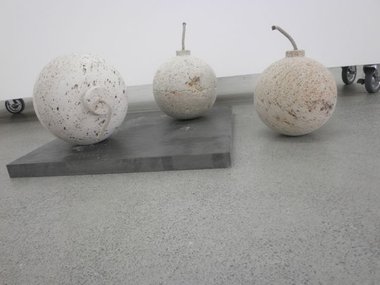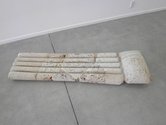John Hurrell – 1 March, 2012
Referencing volcanic ‘bombs' (ejected molten rocks wider than 65 mm across) Gentry has made a variety of pock-marked weapons (balls with wicks, finned canisters) and enlarged children's projectiles that allude to explosive forces, and also recreational objects like balloons, lilos and inner tubes that refer to hovering or floating, that exploit the gaseous weight-supporting properties of enclosed air.
Regan Gentry is well known for his ‘debut’ public art work, Foot in the Door (2004), photographing a foot long ruler jammed into every accepting art institution’s front entrance. It attracted many sighs of admiration for its sheer gall: an unknown artist cockily knocking on municipal gallery doors, openly hustling to get in their collections. Other works, like the gorse carvings shown at Te Tuhi, are different. They are more sociological, exploring history and the gorse plant’s impact on our rural culture.
This current Whitespace exhibition shows off Gentry’s carving expertise again, but this time using laminations of volcanic pumice, different coloured and textured chunks of aerated hokey-pokey rock, glued, shaped and sanded. It is a show that has fun with language without being conceptual - for it flirts with, without developing, ideas. The titles or subject matter create excuses (intellectual justifications - if required) for making objects but not going far beyond their physical properties or simple punning.
Referencing volcanic ‘bombs’ (ejected molten rocks wider than 65 mm across) he has made a variety of pock-marked weapons (balls with wicks, finned canisters) and enlarged children’s projectiles that allude to explosive forces, and also recreational objects like balloons, lilos and inner tubes that refer to hovering or floating, that exploit the gaseous weight-supporting properties of enclosed air.
There is also a large carved skull which exploits the worn, slightly bubbly texture old bones sometimes have, as if made with an ossifying liquid poured into a mould and left to set.
From this we can see that properties inherent within the carved substance dictate the subject matter and implied narrative. Yet if he wished Gentry could be wilder in his imagery, more theatrical and dreamlike - perhaps introducing human figures, using ‘floating’ as an existential metaphor for bare survival. There’s a Bob Dylan line: people don’t live or die, people just float that hints of that, plus a whiff of the transmigration of souls.
With this material my view is that Gentry could exploit his manual dexterity further by moving into a more immersive presentation, getting away from discrete art objects, and incorporating instead many multiple elements hanging from the ceiling (as some do here) - using space as a dynamic ingredient within his practice. So far the advantages of the lightness of pumice have only been hinted at.
John Hurrell
Recent Comments
John Hurrell
Excellent comment Owen. Thanks for pointing that out. The implication is that Regan, and maybe myself, have confused the two. ...
Owen Pratt
Volcanic bombs are formed by molten lava being expelled from the eruption and solidifying in various distinct forms; hence the ...







 Advertising in this column
Advertising in this column Two Rooms presents a program of residencies and projects
Two Rooms presents a program of residencies and projects



This Discussion has 2 comments.
Comment
Owen Pratt, 10:02 a.m. 1 March, 2012 #
Volcanic bombs are formed by molten lava being expelled from the eruption and solidifying in various distinct forms; hence the more common name, lava bomb. Pumice is material formed by the gaseous effervescence of a volcanic eruption and does not feature the typical forms of the volcanic bomb. Pumice floats, lava bombs sink; or am I missing the point?
http://facweb.bhc.edu/academics/science/harwoodr/GEOL101/Labs/VolcanicMaterials/
John Hurrell, 10:26 a.m. 1 March, 2012 #
Excellent comment Owen. Thanks for pointing that out. The implication is that Regan, and maybe myself, have confused the two. I guess the fact that both come out of volcanoes allows him to play with the word 'bomb' and make a pumice weapon.
Participate
Register to Participate.
Sign in
Sign in to an existing account.